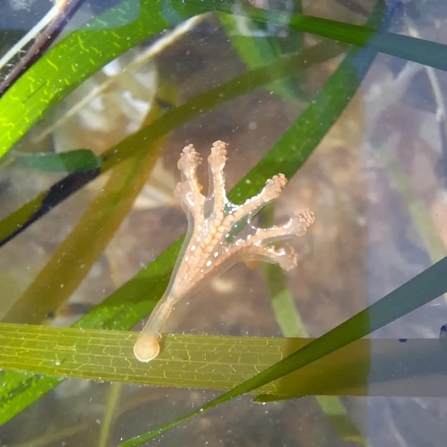Having learnt my lesson from the previous soggy session, I ditched the wellies and went for wetsuit shoes and shorts, which the best advice I could give to any potential volunteers: Give up on staying dry, get stuck in and embrace the meadow! If I’d been distracted trying to keep my feet dry then who knows if I’d have spotted four Stalked Jellies, countless Rock Pool Shrimp, crabs galore (including a particularly gutsy Velvet Crab that squared off at me when I startled it, which was I’m afraid more adorable than intimidating), and so many little flashes of silver that I couldn’t begin to guess how many small fry were growing up in the safety of the seagrass, or how many tiny fish had made the meadow their home.
Solent Seagrass Champion helping collect seagrass seeds to make our seas wilder!
© Jamie Marsh

© Jamie Marsh
So, waders armed with buckets and snorkellers clutching at mesh bags, we made our way down the deserted beach. We were looking for spathes at stages four and five, that’s either lovely pale seeds, ready to harvest but still securely in the yellowy-green spathe, or those that are dark and murky, poised to drop at any moment. I say “looking”, the meadow was absolutely bursting with seeds. All you had to do was stand about knee-deep amongst the amazing leaves and the pale, buoyant little spathes would wave up at you, almost saying “Pick me!”. I wonder, do they stand out in the hope that waterfowl will eat and therefore distribute the seeds? That’s another thing about seagrass meadows, the life contained within is so diverse and abundant that it’s impossible to be amongst it all without noticing some new element or musing on the ecosystem itself.

© Jamie Marsh
Luckily as I said, there were so many seeds that we could afford to get a little distracted by the beauty of the place, which I think is yet another reason why restoration and protection is vitally important. Seagrass meadows are so wonderful that they can reduce grown adults to excited kids again, whooping whenever we see a creature move and clustering round just to get a glimpse of a tiny stalked jelly. I also learnt from chatting with other volunteers just how special and impressive the Island meadows are. Being local to them it’s easy to assume they’re archetypal but this is not so, another volunteer told me that seeing the state some mainland “meadows” are in made him genuinely sad. Despite these interludes I got my eye in quickly, and by the time the tide began to turn and force us back to dry land we’d all comfortably collected a couple of hundred seeds each. Over the
course of six sessions, I feel confident saying that my personal total must be in the thousands!
Back up the shore, we deposited our spathe hauls in a big trug half-full of seawater, keeping them nice and damp so they were protected for their journey to the lab at the Institute of Marine Sciences. By now they’ll be rotting out in big tanks, releasing individual seeds ready for us to sort and eventually plant, I personally can’t wait to get back to them!
Imogen, Solent Seagrass Champion




